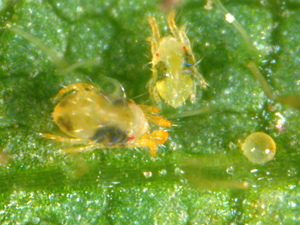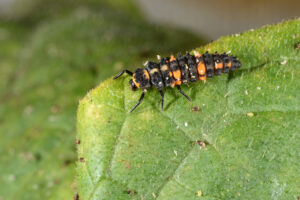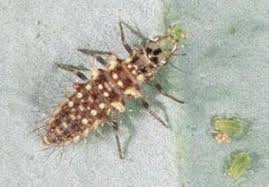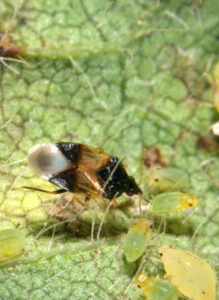This season started out dry and hot. These are the ideal conditions for pests that we often associate with controlled environments: aphids and mites. There are a number of factors that contribute to their success in these conditions, including lack of rain which physically removes the insect from the plant and drought-stressed plants, which are a more suitable host. The pest populations increase rapidly under these conditions, so it is crucial to be scouting on a weekly basis at the least. Early detection and treatment are key. In protected environments, prevention and early intervention are especially important; In the field, heavy rains can help knock these pests back.
Twospotted spider mites (TSSM) are one of the most common mite pests in vegetables (Figure 1). TSSM occurs throughout the world. They are known to feed on over 300 plant species, including tomatoes, cucumbers, melons, grapes, apples, and a variety of common flower and weed species. They disperse by walking or flying on the wind currents. The adults are pale green to yellowish in color or almost appear translucent, with two black spots on their backs. Eggs and nymphs are present and overlap with adults. The eggs are very small yellowish or translucent circles, and the nymphs are yellowish to green in color. Spots are not present until they are mature.
Early infestations can be spotted by scouting the leaves for the characteristic stippling that occurs as a result of mite feeding, then turn over the leaf to look for the pest or feeding damage resulting from the pest scraping the contents from the plant cells (Figure 2). As infestations build you will be able to spot the characteristic webbing that these mites build, leading to their name. TSSM can be found on the underside of leaves with a 10X hand lens.
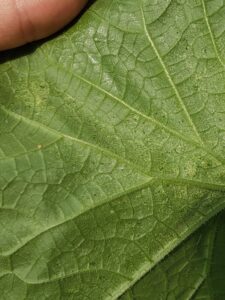
Figure 2. Stippling damage on the underside of a cucumber leaf, resulting from twospotted spider mite feeding (Photo by Laura L. Ingwell).
There are numerous species of aphids, but those that we encounter most often in vegetables include the green peach aphid, potato/tomato aphid and melon aphid. Don’t let their names fool you. They can feed on hosts beyond what the name entails. When it comes to scouting and management, in most situations species identification is not crucial. What is important is to be looking at both the upper and lower surface of the leaves to monitor populations. Often times it is easier to spot the shed skin (or exuvia; Figure 3) from the aphids molting from one life stage to the next or the shiny secretions of honeydew on the leaves.
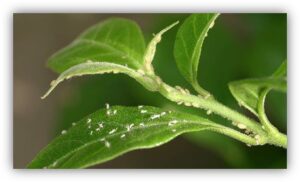
Figure 3. Exuvia or shed skin from aphids molting from one life stage to the next. The aphids are also seen in the photo (Photo by Laura L. Ingwell).
For both of these pests, there are a number of natural enemies that are present and contribute to their population control. Scouting is key so that you can spot populations early, mark them with a flag, and then monitor their spread to see if there is natural pest management occurring. For mites in particular, their natural enemies tend to be even smaller predatory mite species, so you can’t necessarily see them. Some of the aphid predators you will be able to identify, and others not. The more obvious predatory insects include lady beetles (Figure 4), lacewings (Figure 5), and the minute pirate bug (Figure 6). The more conspicuous are the syrphid fly larvae (Figure 7), predatory mites (Figure 8), and parasitic wasps (look for aphid mummies; Figure 9).
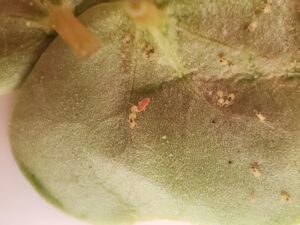
Figure 7. The larva of a syrphid fly preying upon twospotted spider mites. The larva is the pink worm-like maggot in the photo (Photo by Laura L. Ingwell).
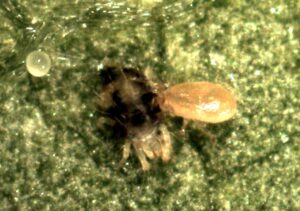
Figure 8. The predatory mite species Neoseiulus fallacis, preying upon a spider mite (Photo by Samantha Willden).
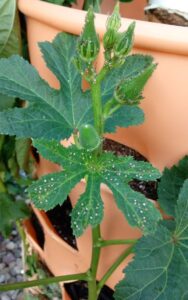
Figure 9. The aphid mummies are the white or bronze bodies, some of which have a small hole in the back. This is the result of it being parasitized by a tiny wasp. The adult wasp emerges through the hole it chews in the aphid carcass (Photo by Laura L. Ingwell).
There are a variety of insecticides/miticides available to treat these pests, such as those containing abamectin (Agri-Mek®), bifenthrin (Brigade®), spriomesifen (Oberon®), acequinocyl (Kanemite®), fenpyroximate (Portal®). For aphids, I highly recommend flonicamid (Beleaf®). It may come with a higher price tag but is worth it. This product only impacts piercing-sucking plant pests. It is safe for natural enemies and pollinators. Furthermore, in high tunnel growing environments, we have achieved complete control with one application. The product ceases feeding of the pest, and therefore it takes some time to see the results, but the population will desiccate on the plant and die.
When making any pesticide applications this time of year, it is important to consider the impacts of the application on non-target organisms, such as predatory insects and pollinators. Some of the chemistries available have less impact on these beneficial insects. Choosing a chemistry that has fewer non-target impacts according to the labels, such as Portal. Also, make applications as late in the day as possible, when the flowers have closed and pollinators are less active. For more information on protecting pollinators in your fruit and vegetable crops, read this publication on production practices and this one for commercial applicators.
